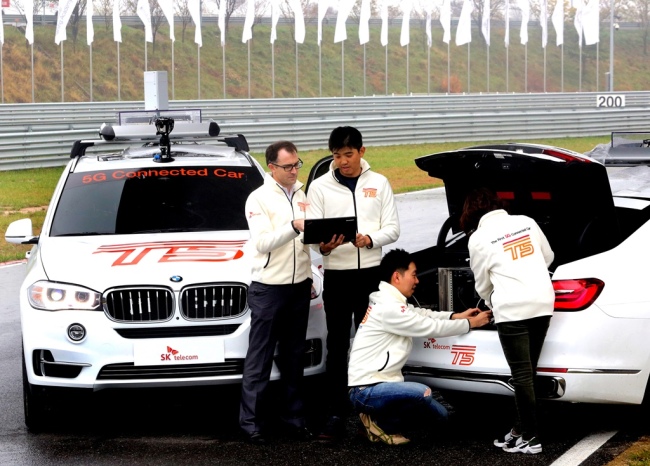As mobile data networks speed up, autonomous vehicles fully connected to their surroundings are expected to become a reality in the near future.
While other technologies will be required for the commercialization of self-driving cars, South Korean carrier SK Telecom zeroed in on how next-generation 5G networks will serve as a foundation for these futuristic vehicles in a live demonstration here Tuesday.
At the 240,000 square-meter BMW Driving Range in Incheon, SKT unveiled the T5, an experimental connected car running on a 5G trial network deployed by SKT and Ericsson. Two T5 units were built by installing 5G terminals inside two BMW vehicles -- the new X5 and 7 Series.
 |
SK Telecom employees prepare the T5, a connected car running on a 5G trial network, for a test run at the BMW Driving Center in Incheon. SKT built two T5 units by installing 5G terminals inside two BMW vehicles -- the new X5 and 7 Series. (SK Telecom) |
5G, which is geared for full commercialization in 2020, is an ultra-fast data network offering up to 20 times faster transmission speeds than the existing 4G Long-Term Evolution networks. 5G has extremely low latency — or delays caused when transmitting large amounts of data.
This ultra-fast network is considered an integral part of enabling stable and continuous communication between a car and any entity that may affect it, including other cars, road sensors and pedestrians. Achieving this constant connectivity is a prerequisite to developing safe and reliable autonomous cars.
During the Tuesday demonstration, two T5 vehicles traveled on the road while communicating in real-time with each other. When the vehicle in front suddenly braked at a blind corner, it sent a video via 5G to the nearby vehicle, which was immediately informed of the incident.
In addition, a drone flying overhead consistently provided streaming footage of a bird’s eye view of the roads to offer the driver a more wholesome picture of the road situation, potential accidents and blockades.
“Such features can help prevent accidents and improve road safety, because drivers can be informed of what lies ahead beyond their own view,” said rapper-turned-racer Kim Jin-pyo, who ran the test drive on behalf of SKT.
 |
A multi-screen display shows rapper-turned-racer Kim Jin-pyo test driving the T5 in a demonstration held at the BMW Driving Center in Incheon, Tuesday (Sohn Ji-young/The Korea Herald) |
According to SKT’s chief technology officer Choi Jin-sung, the Tuesday demonstration marked the world’s first “field case” in which a 5G trial network was applied to a connected car traveling on the road to offer a glimpse of 5G’s real-life future applications.
“If 5G is the next-generation network platform, connected cars are the services that function within that platform,” Choi said. “5G is going to lead us to technologies that have never been seen before.”
In terms of transportation, connected cars would obtain unlimited data on their surroundings via 5G, making driving, parking and general car navigation more convenient and eventually autonomous. The time spent driving would be filled by other tasks, Choi said.
Looking ahead, 5G networks are likely to be commercialized worldwide in 2020. However, this does not necessarily suggest that self-driving cars will also become available by then as well, said Martin Woehrle, BMW Group Korea’s senior director and head of R&D Center Korea.
“The timetable of autonomous driving is independent of 5G development,” said Woehrle, pointing out that while 5G is a core part of autonomous vehicles, there are still many steps left in merging a stable 5G network to a moving vehicle.
“For instance, beams and antennas in the cars must be designed in a way so that we can use 5G in automobiles traveling at 250 kph. Once we get reliable signals, we can move forward,” he said.
By Sohn Ji-young (
jys@heraldcorp.com)









